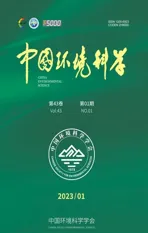珠江三角洲秋季生物质燃烧对有机气溶胶的贡献
2023-02-04叶晨朔王思行何贤俊张潇潇胡伟伟
杨 磊,袁 斌*,郑 锷,叶晨朔,王思行,何贤俊,张潇潇,黄 山,胡伟伟,邵 敏
珠江三角洲秋季生物质燃烧对有机气溶胶的贡献
杨 磊1,袁 斌1*,郑 锷1,叶晨朔2,王思行1,何贤俊1,张潇潇1,黄 山1,胡伟伟3,邵 敏1
(1.暨南大学环境与气候研究院,粤港澳环境质量创新联合实验室,广东 广州 511443;2.北京大学环境科学与工程学院,北京 100871;3.中国科学院广州地球化学研究所,有机地球化学国家重点实验室,广东 广州 510640)
本研究基于2018年和2019年秋季在珠江三角洲地区的两次外场观测,应用热脱附-化学电离飞行时间质谱(FIGAERO-ToF-CIMS)获取了高时间分辨率(每小时)的生物质燃烧示踪物左旋葡聚糖的浓度数据,并估算出生物质燃烧对有机气溶胶(OA)的贡献值.结果表明,秋季珠江三角洲地区城市站点和区域站点的左旋葡聚糖平均浓度分别为(0.07±0.08)和(0.14±0.12)μg/m3,呈现区域站点高于城市站点的空间分布特征以及早晨和夜间出现峰值的日变化特征.观察到两个站点的左旋葡聚糖与CO和乙腈之间相关性较低,但与OA之间呈现显著正相关关系.进一步基于受体示踪物法估算出生物质燃烧对OA的平均贡献分别为7.4%(城市站点)和11.4%(区域站点),且两个站点均显示出生物质燃烧对OA的贡献在夜间明显高于白天.
生物质燃烧;示踪物;左旋葡聚糖;有机气溶胶
生物质燃烧是一种重要的空气污染源,对全球范围内的空气质量、气候变化和人类健康都有着复杂且重要的影响[1-3].特别是农作物秸秆露天焚烧和家庭炉灶燃烧等生物质燃烧过程[4-5],会释放多种气体及颗粒物,包括温室气体(如二氧化碳)、挥发性有机化合物(VOCs)和由黑碳(BC)、棕碳(BrC)及其他有机物组成的颗粒物[6].这些污染物不仅会对区域大气产生不利影响,而且还可以通过长距离输送影响全球空气质量[7].
珠江三角洲地区(以下简称“珠江三角洲”)是中国最发达的地区之一,也是我国重要的农业生产基地,农作物残余物露天焚烧引起的大气污染事件经常发生[8-9].有机气溶胶(OA)作为大气细颗粒物(PM2.5)的重要组成部分,占PM2.5总质量的20~90%[10-11].而生物质燃烧排放则被认为是大气颗粒物中OA的重要来源[12],特别是在生物质燃烧影响较大的地区(例如我国关中盆地),甚至可以贡献31.9%的OA[13].此前研究表明,OA能够影响大气颗粒物的物理化学特性,如吸湿性和光学特性等,进而通过改变光的散射和吸收影响大气能见度和气候变化.例如,Zong等[14]研究发现OA中的水溶性有机物(WSOM)可以改变气溶胶吸湿性,从而影响气溶胶作为云凝结核的能力.Saleh等[15]研究发现BrC作为一类吸光性的OA组分,其在近紫外线和可见光谱区域具有很强的吸光能力,从而影响大气辐射传输过程.大量研究都关注到生物质燃烧对大气气溶胶中OA的贡献及影响[16-18],但目前人们对我国珠江三角洲地区秋季城市站点和区域站点的生物质燃烧贡献差异了解甚少,在此地区开展研究有利于补充对珠江三角洲不同地区大气有机气溶胶受生物质燃烧源影响现状的认识,为制定城市和区域尺度大气细颗粒物防治策略提供依据.
左旋葡聚糖(1,6-脱水-β-D-吡喃糖)是纤维素的主要热解产物,被广泛作为生物质燃烧的示踪剂[19-21].左旋葡聚糖的测定通常采用气相色谱-质谱法(GC-MS)或高效液相色谱法(HPLC),分析方法成熟,但两种方法都涉及复杂的样品处理和分析过程,且时间分辨率较低[22-23].近年来,将气粒双通道采样器(FIGAERO)作为进样口的热脱附-化学电离飞行时间质谱仪(FIGAERO-ToF-CIMS)测定左旋葡聚糖的方法已被运用[24-25].这种新型的在线检测技术使用软电离的化学电离方式以实现待测物离子最小程度的碎片化,并且具有极低的检测限,可在分子水平上在线检测和定量含氧化合物,无需复杂的样品处理过程,同时具有高时间分辨率[26-27].
本文使用FIGAERO-ToF-CIMS在珠江三角洲地区开展秋季外场观测,获取高时间分辨率(每小时)的左旋葡聚糖浓度数据,分析其空间分布特征和日变化特征,并与其他生物质燃烧示踪物进行相关性分析,以了解珠江三角洲地区城市站点和区域站点之间生物质燃烧活动的差异.通过左旋葡聚糖浓度和OA浓度对生物质燃烧贡献值进行估算以分析大气气溶胶中OA受生物质燃烧的影响程度,为我国珠江三角洲地区秋季生物质燃烧引起的大气细颗粒物污染的防控提供数据支持.
1 材料与方法
1.1 采样地点
本研究使用2018年和2019年秋季在珠江三角洲地区分别进行的两次外场观测数据.珠江三角洲地区包括广州、佛山、肇庆、深圳、东莞、惠州、珠海、中山和江门9个城市,是我国经济最活跃、人口最密集的区域之一,工业化、城市化水平较高.城市站点位于广东省广州市中国科学院广州地球化学研究所(23.1°N,113.2°E),周边主要是居民区和学校,无明显工业排放源,属于典型的城市环境[28-29],观测时间自2018年9月27日~2018年11月12日.区域站点位于广东省江门市鹤山市广东省大气环境超级监测站(22.7°N,112.9°E),距离广州市市区约80km,周边无明显工业源且处于城市下风向,是珠江三角洲地区典型的区域受体站点[30-31],观测时间自2019年10月2日~2019年11月15日.
1.2 左旋葡聚糖分析方法
观测期间采用以FIGAERO为进样口的碘离子化学电离飞行时间质谱(I--ToF-CIMS)测量左旋葡聚糖, I--ToF-CIMS可检测的质量范围为1~603Th,质量分辨率为10000~11000[32-33].FIGAERO作为一个多端口进气装置,拥有单独的气体采样口和颗粒物采样口,并通过FIGAERO内可移动滑块来控制气体或颗粒物从不同进样口进入仪器来实现在线测量大气中微量气体和气溶胶颗粒物的化学组分.具体采样方法为6h的采样循环,在每1h的采样周期内FIGAERO以两种模式进行工作:(1)前24min进行气态物质实时分析和颗粒物的采集,颗粒物被收集在Teflon膜上;(2)后36min将收集到的颗粒物经高温氮气热解吸进行颗粒物分析.在每36min的颗粒态模式下将收集到的颗粒物热解吸,以2L/min的氮气为载气引入仪器,氮气在12min内从环境温度升高到175℃,并保持20min.当经历5个相同的采样周期后,通过电磁阀切换进行颗粒物空白采样作为背景,形成6h的采样循环,以实现颗粒态数据为1h的高时间分辨率.左旋葡聚糖的标定在实验室和外场观测中进行,以保证仪器运行期间数据的准确性.仪器运行期间,人为将不同浓度的左旋葡聚糖标准溶液注射在FIGAERO的Teflon膜上并按颗粒态热脱附模式升温以确定左旋葡聚糖的响应因子.
1.3 其他数据分析方法
本次观测对于乙腈的测量,使用在线质子转移反应飞行时间质谱(PTR-ToF-MS),因其具有高时间分辨率,高灵敏度,检测限较低等特点,已广泛应用于外场观测[34-35].仪器运行期间,每天利用标准气体在干燥条件和湿度条件进行多点标定,并根据实验室湿度实验以准确定量乙腈浓度[30,36].对于常规痕量气体CO的测量,使用增强型痕量CO分析仪(型号:48i-TLE)进行了连续在线监测.对于颗粒物中OA浓度的测量,使用Aerodyne公司所研发的高分辨率黑碳飞行时间质谱仪(SP-HR-ToF-AMS)[37-38],可满足对环境大气中气溶胶的化学组分(包括有机物、硫酸盐、硝酸盐、铵盐和氯盐)的监测.
2 结果与讨论
2.1 左旋葡聚糖的浓度水平及空间分布特征
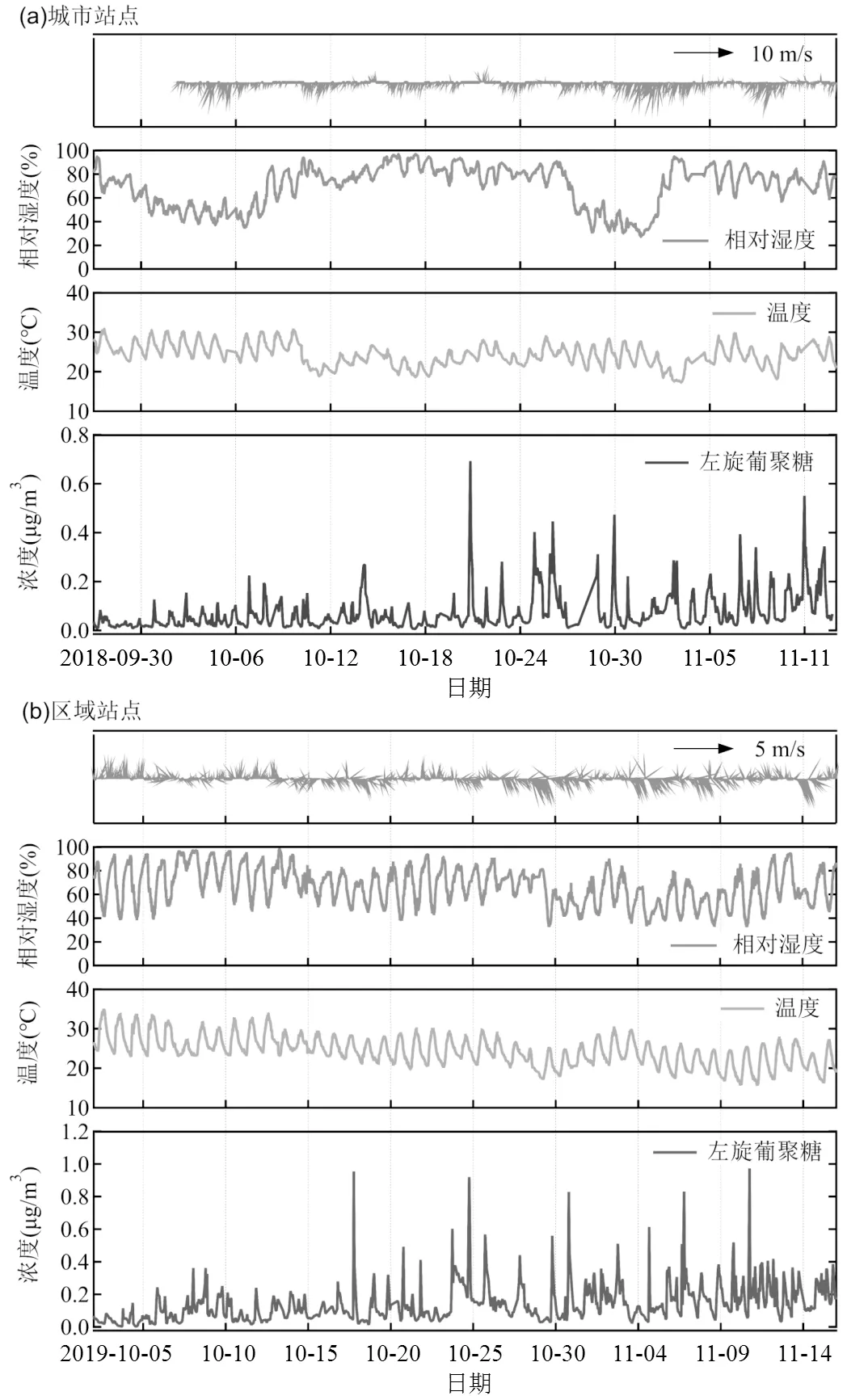
图1 观测期间气象参数和左旋葡聚糖的时间序列
观测期间各站点气象参数的时间序列如图1所示,可以看出城市站点和区域站点的平均温度分别为(24.2±2.7)和(24.4±3.6)℃,平均湿度分别为(70.1± 17.5)和(66.9±15.4)%,且两个站点的主导风向为偏北风,平均风速分别为(2.4±1.4)和(1.5±0.8)m/s,较快的风速有利于污染物区域输送[39].
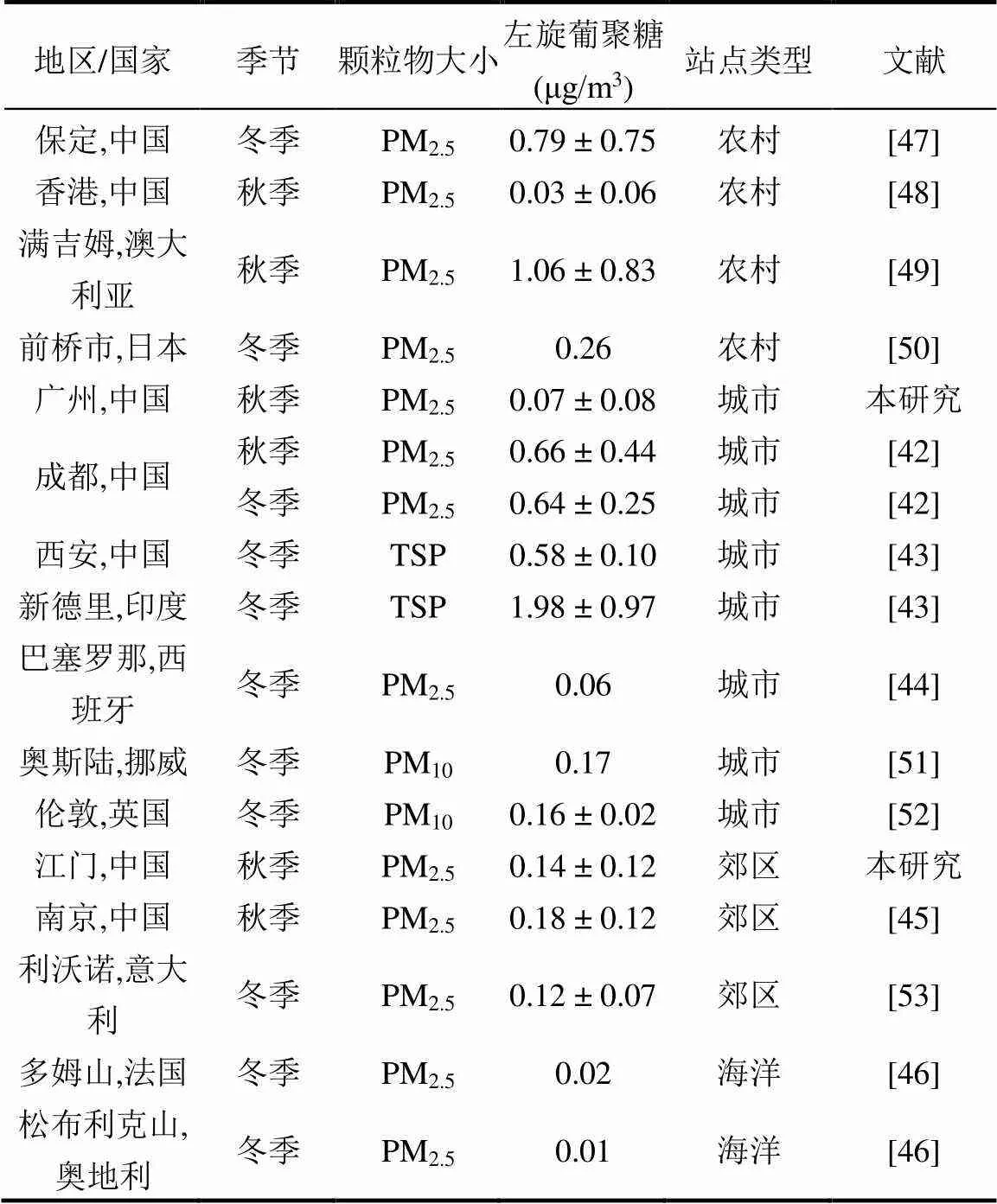
表1 国内外主要城市秋冬季节大气颗粒物中左旋葡聚糖浓度水平
通过高时间分辨率测量,观测期间两个站点的左旋葡聚糖平均浓度及变化范围见表1和图1.由表1可知,珠江三角洲地区城市站点的平均浓度低于区域站点,分别为(0.07±0.08)和(0.14±0.12)μg/m3.在2018和2019年10月中旬前左旋葡聚糖的浓度水平未出现明显高值,基本处于0.40μg/m3以下的较低水平,于10月中下旬才会在傍晚及夜间出现高值,其原因可能是由于此时珠江三角洲地区已经步入秋收时期,大量农作物残余物被就地露天焚烧,较高的左旋葡聚糖浓度与周边及当地的生物质燃烧事件直接相关[40].这与Yuan等[41]以乙腈为生物质燃烧示踪物,发现珠江三角洲地区10月下旬开始存在普遍焚烧农作物残余物的现象一致.具体来看,城市站点的最高小时平均浓度出现在10月20日的夜间(0.69μg/m3),区域站点于10月17日开始浓度有所上升,最高小时平均浓度出现在11月18日的傍晚(0.97μg/m3).表明我国珠江三角洲地区秋季左旋葡聚糖浓度呈现区域站点高于城市站点的空间分布特征.
本研究将测量的左旋葡聚糖与其他国内外城市秋冬季节报道的浓度水平进行了比较.从表1可以看出,城市站点测得的左旋葡聚糖平均浓度远低于秋季成都(0.66μg/m3)和西安(0.58μg/m3)[42-43],与冬季西班牙巴塞罗那(0.06μg/m3)相近[44].区域站点测得的左旋葡聚糖平均浓度与秋季南京(0.18± 0.12)μg/m3相近[45],但远高于冬季法国多姆山(0.02μg/m3)等海洋地区[46].总体而言,我国珠江三角洲地区秋季左旋葡聚糖浓度低于华北及西南等地区,与欧洲地区观察到的浓度大致相当.
2.2 左旋葡聚糖的日变化特征
化学示踪物是目前辨析生物质燃烧事件和量化其对大气环境影响的常用研究手段[54].作为典型的生物质燃烧示踪物,观测期间两个站点的左旋葡聚糖日变化特征如图2所示,从图2反映了各站点左旋葡聚糖浓度随时间基本呈现早晨和夜间出现峰值的变化趋势.在早晨,区域站点的浓度持续上升,并于早晨8:00左右出现峰值,而城市站点则一直呈现缓慢下降的变化趋势,未观察到明显的峰值变化,表明区域站点在早晨较为明显的生物质燃烧活动,城市站点缺乏重要的生物质燃烧排放源.在夜间,两个站点的左旋葡聚糖浓度均于下午16:00左右开始有明显上升趋势,但上升幅度有所不同.城市站点最大上升幅度出现在19:00~20:00左右,从0.09μg/m3上升到0.14μg/m3,上升幅度为55.6%,并在夜间21:00左右达到峰值,随后浓度开始下降.区域站点最大上升幅度出现在17:00~18:00左右,从0.12μg/m3上升到0.25μg/m3,上升幅度高达108.3%,随后在夜间19:00左右达到峰值,表明我国珠江三角洲地区秋季区域站点受到了更为严重的生物质燃烧污染.相较于区域站点,城市站点的峰值较小且达峰值时间较晚,这种差异可能是因为珠江三角洲地区秋收后农田秸秆露天燃烧活动主要发生在农村地区,城市上风向地区生物质燃烧所排放的污染物可传输至城市区域[55].
除了峰值变化外,同时观察到两个站点左旋葡聚糖浓度总体上均具有夜间高、日间低的特点,通常在午后达到最低值,随着光照的减弱和排放量的增加,浓度开始上升并在夜间达到峰值.这不仅因为珠江三角洲地区夜间生物质燃烧活动频繁以及夜间边界层高度降低等原因,还因为左旋葡聚糖作为半挥发性有机物,其物理化学性质以及环境条件(温度、湿度、悬浮颗粒物浓度等)决定了其在气相和颗粒相中的分配,随着日间环境温度的升高,左旋葡聚糖从颗粒相挥发进入气相[56].同时,目前的研究还发现左旋葡聚糖在大气环境中并不稳定,会与大气中OH自由基发生光化学降解,尤其是在高相对湿度条件下[57-58].因此,左旋葡聚糖的浓度变化会受到源排放、光化学和环境条件等作用的影响.
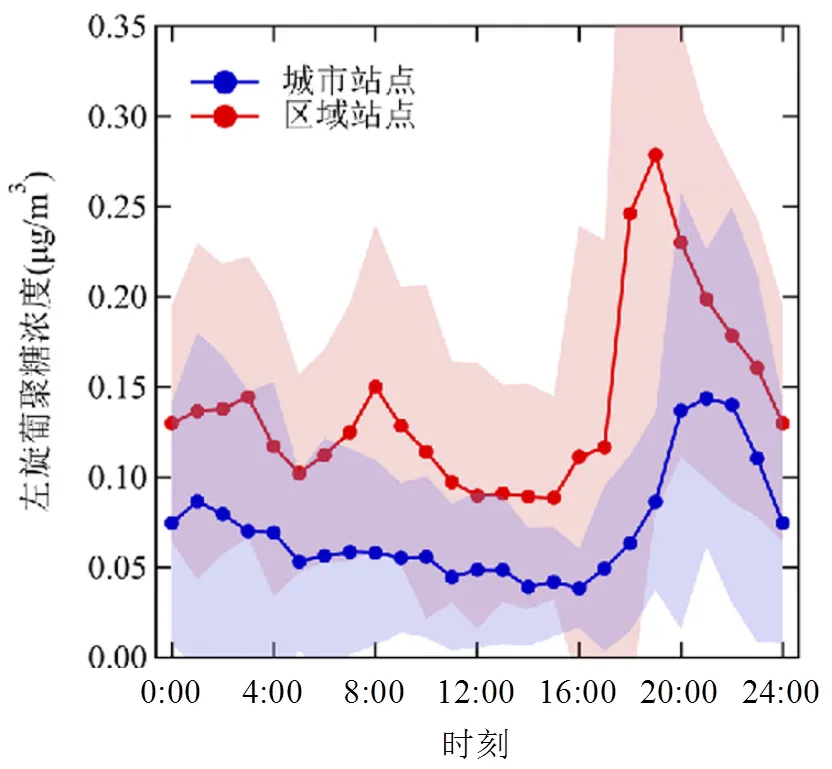
图2 左旋葡聚糖日变化特征图
2.3 左旋葡聚糖与其他生物质燃烧示踪物的相关性
典型的生物质燃烧示踪物有左旋葡聚糖等有机物以及非海盐钾离子等无机物,气态物质如乙腈和氯甲烷等也被认为是生物质燃烧的示踪物[59-61]. CO和乙腈因其稳定性较好且寿命相对较长的特点,已被广泛用于指示生物质燃烧活动[62-63].但研究表明,除了生物质燃烧外,工业排放、汽车排放和燃煤排放也有助于提高它们在大气中的浓度水平[64-65].
本研究将测量的左旋葡聚糖与一次示踪物CO和乙腈进行相关性分析,如图3所示.通过高时间分辨率测量的数据,发现城市和区域站点左旋葡聚糖与CO的具有一定相关性(r=0.43~0.57),在区域站点乙腈的相关性稍高(r=0.59).这表明除了生物质燃烧外,我国珠江三角洲地区秋季CO和乙腈受其他排放源贡献显著,如机动车排放以及燃煤排放.同时,城市站点与区域站点获得的左旋葡聚糖与CO的回归线斜率基本相同,证实城市和区域影响左旋葡聚糖排放的生物质燃烧类型基本相同.此外,传统离线采样提供数据集的时间分辨率一般为1d[16],而高时间分辨率测量则能够捕捉到明显的生物质燃烧排放事件.通过小时值和日均值的比较,可以发现两个站点日均值的相关性要高于小时值,小时值的相关性低,更加凸显高时间分辨率测量条件下,普通城市排放和生物质燃烧排放的差异.因此,高时间分辨率的测量更易捕捉到生物质燃烧排放事件,也更有助于了解生物质燃烧排放与城市其他排放的差异.

图3 左旋葡聚糖与一氧化碳和乙腈的散点图
2.4 生物质燃烧排放对OA的贡献
在生物质燃烧过程中,植物的纤维素和半纤维素高温裂解形成脱水糖类物质,其中左旋葡聚糖是气溶胶中含量最高的脱水糖类化合物,其次是甘露糖和半乳糖,故将左旋葡聚糖作为示踪物判断生物质燃烧对OA的贡献[66-67].珠江三角洲地区城市站点和区域站点的OA平均浓度分别为(19.2±12.6)和(19.2±8.9)μg/m3.从图4可以看出,两个站点中测得的左旋葡聚糖与OA之间均呈现显著的正相关关系,这表明生物质燃烧是我国珠江三角洲地区秋季大气气溶胶中OA的重要来源.
左旋葡聚糖与OA的比值(Levoglucosan/OA)已被用于估算生物质燃烧对OA的贡献,本研究进一步通过受体示踪物法,利用示踪物左旋葡聚糖与OA浓度通过下式对生物质燃烧贡献进行估算:

式中:(Levoglucosan/OA)环境代表观测期间左旋葡聚糖与OA的平均比值;(Levoglucosan/OA)源代表生物质燃烧源谱中左旋葡聚糖与OA的比值.基于Zhang等[68]和Li等[69]研究得到中国谷类秸秆(水稻、小麦和玉米)燃烧排放的PM2.5中左旋葡聚糖对OC的平均排放因子(8.2%)和OA/OC比值(1.3),本研究估算出两个站点中生物质燃烧对OA的平均贡献分别为7.4%(城市站点)和11.4%(区域站点).由图5可知,生物质燃烧对城市站点OA的贡献在夜间22:00左右达到峰值(13.3%),对区域站点OA的贡献在夜间19:00左右达到峰值(18.3%).表明我国珠江三角洲地区秋季生物质燃烧排放对OA的贡献在夜间明显高于白天.
同时,Huang等[16]和He等[17]分别于2008年和2009年利用受体模型正矩阵因子分解法(PMF)对高分辨率气溶胶质谱仪测得的秋季珠江三角洲农村站点和城市站点的OA进行来源识别与定量,解析出生物质燃烧源(BBOA)对OA的贡献分别为24.5%和24.1%.本研究结果要低于该值,但与Zhu等[70]和Cao等[71]分别于2014年和2015年秋冬季在珠江三角洲城市站点的观测结果(12.6%和8.9%)相近,说明近年来通过实施严格的空气污染防治措施,使珠江三角洲地区大规模露天焚烧农田秸秆的生物质燃烧活动得到了一定控制[72-73].此外,除了对珠江三角洲地区的研究, Zhang等[74]发现长三角地区夏季小麦收获和秋季水稻收获期间的BBOA的贡献值为36%~39%,以及Xu等[75]发现与以往其他季节相比,生物质燃烧源对北京城市地区OA的贡献在秋季更加显著(20%).因此,我国珠江三角洲地区秋季生物质燃烧排放对大气气溶胶中OA的贡献虽然没有京津冀和长三角地区高,但对珠江三角洲地区大气细颗粒物污染的影响不可忽视,特别是珠江三角洲农村及周边地区秋收后大规模的生物质开放式燃烧活动.
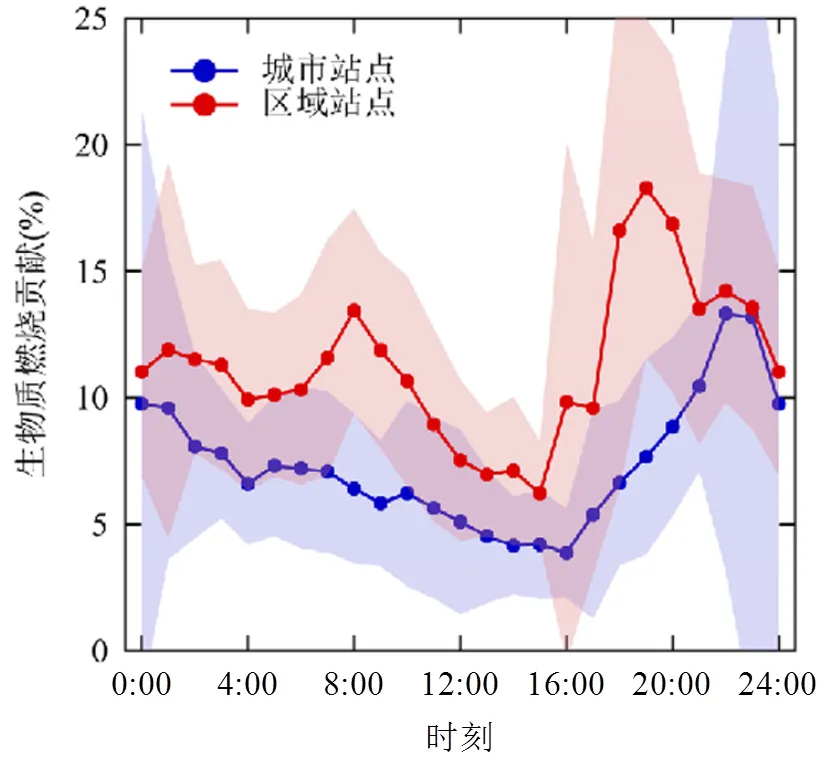
图5 生物质燃烧对OA贡献的日变化特征
3 结论
3.1 通过高时间分辨率测量,观测期间城市站点和区域站点的左旋葡聚糖平均浓度分别为(0.07±0.08)和(0.14±0.12)μg/m3,表明我国珠江三角洲地区秋季左旋葡聚糖浓度呈现区域站点高于城市站点的空间分布特征,且与其他国内外城市相比,珠江三角洲地区浓度低于华北及西南等地区,与欧洲地区大致相当.
3.2 两个站点的左旋葡聚糖浓度随时间基本呈现早晨及夜间出现峰值的变化趋势,相较于区域站点,城市站点的峰值较小且达峰值时间较晚,这种差异可能是因为珠江三角洲地区秋收后农田秸秆露天燃烧活动主要发生在农村地区,城市上风向地区生物质燃烧所排放的污染物可传输至城市区域.
3.3 两个站点观测到左旋葡聚糖与CO和乙腈的相关性较差,表明除了生物质燃烧外,我国珠江三角洲地区秋季CO和乙腈受其他排放源贡献显著,如机动车排放以及燃煤排放.通过小时值和日均值的比较,可以发现两个站点日均值的相关性要高于小时值,小时值的相关性低,更加凸显高时间分辨率测量条件下,普通城市排放和生物质燃烧排放的差异.
3.4 基于受体示踪物法估算出生物质燃烧对OA的平均贡献分别为7.4%(城市站点)和11.4%(区域站点),生物质燃烧对城市站点OA的贡献在夜间22:00左右达到峰值(13.3%),对区域站点OA的贡献在夜间19:00左右达到峰值(18.3%).表明我国珠江三角洲地区秋季生物质燃烧排放对OA的贡献在夜间明显高于白天.且与其他国内城市相比,我国珠江三角洲地区秋季生物质燃烧排放对大气气溶胶中OA的贡献虽然没有京津冀和长三角地区高,但对珠江三角洲地区大气细颗粒物污染的影响不可忽视,特别是珠江三角洲农村及周边地区秋收后大规模的生物质开放式燃烧活动.
[1] Randerson J T, Liu H, Flanner M G, et al. The impact of boreal forest fire on climate warming [J]. Science, 2006,314:1130-1132.
[2] Marlier M E, Defries R S, Voulgarakis A, et al. El Nino and health risks from landscape fire emissions in Southeast Asia [J]. Nature Climate Change, 2013,3:131-136.
[3] Andela N, Morton D C, Giglio L, et al. A human-driven decline in global burned area [J]. Science, 2017,356:1356-1362.
[4] Chen J M, Li C L, Ristovski Z, et al. A review of biomass burning: Emissions and impacts on air quality, health and climate in China [J]. Science of The Total Environment, 2017,579:1000-1034.
[5] 赵金平,钟英立,徐小静,等.南方地区典型生物质燃烧锅炉二噁英排放污染特征 [J]. 中国环境科学, 2017,37:3473-3480.
Zhao J P, Zhong Y L, Xu X J, et al. Research on pollution characteristic of dioxin emitted from typical biomass combustion boiler in southern region [J]. China Environmental Science, 2017,37: 3473-3480.
[6] Li X H, Wang S X, Duan L, et al. Particulate and trace gas emissions from open burning of wheat straw and corn stover in China [J]. Environmental Science & Technology, 2007,41:6052-6058.
[7] Wang Y J, Hu M, Lin P, et al. Enhancement in particulate organic nitrogen and light absorption of humic-like substances over Tibetan Plateau due to long-range transported biomass burning emissions [J]. Environmental Science & Technology, 2019,53:14222-14232.
[8] Wang B L, Liu Y, Shao M, et al. The contributions of biomass burning to primary and secondary organics: A case study in Pearl River Delta (PRD), China [J]. Science of the Total Environment, 2016,569-570: 548-556.
[9] 王丽娟,吴大磊,张智胜.广州城区大气颗粒物中典型生物质燃烧示踪物特征分析 [J]. 中国科学院大学学报, 2017,34:567-572.
Wang L J, Wu D L, Zhang Z S. Characterization of typical biomass burning tracers among atmospheric particles in urban Guangzhou [J]. Journal of University of Chinese Academy of Sciences, 2017,34:567- 572.
[10] Kanakidou M, Seinfeld J H, Pandis S N, et al. Organic aerosol and global climate modelling: a review [J]. Atmospheric Chemistry and Physics, 2005,5:1053-1123.
[11] 唐荣志,王 辉,刘 莹,等.大气半/中等挥发性有机物的组成及其对有机气溶胶贡献 [J]. 化学进展, 2019,31:180-190.
Tang R Z, Wang H, Liu Y, et al. Constituents of atmospheric semi- volatile and intermediate volatility organic compounds and their contribution to organic aerosol [J]. Progress in Chemistry, 2019,31: 180-190.
[12] Reddy M S, Boucher O. A study of the global cycle of carbonaceous aerosols in the LMDZT general circulation model [J]. Journal of Geophysical Research-Atmospheres, 2004,109:1-22.
[13] Zhong H B, Huang R J, Duan J, et al. Seasonal variations in the sources of organic aerosol in Xi'an, Northwest China: The importance of biomass burning and secondary formation [J]. Science of the Total Environment, 2020,737:139666.
[14] Zong Z, Wang X, Tian C, et al. Source and formation characteristics of water-soluble organic carbon in the anthropogenic-influenced Yellow River Delta, North China [J]. Atmospheric Environment, 2016,144: 124-132.
[15] Saleh R, Robinson E S, Tkacik D S, et al. Brownness of organics in aerosols from biomass burning linked to their black carbon content [J]. Nature Geoscience, 2014,7:647-650.
[16] Huang X F, He L Y, Hu M, et al. Characterization of submicron aerosols at a rural site in Pearl River Delta of China using an aerodyne high-resolution aerosol mass spectrometer [J]. Atmospheric Chemistry and Physics, 2011,11:1865-1877.
[17] He L Y, Huang X F, Xue L, et al. Submicron aerosol analysis and organic source apportionment in an urban atmosphere in Pearl River Delta of China using high-resolution aerosol mass spectrometry [J]. Journal of Geophysical Research-Atmospheres, 2011,116:1-15.
[18] 祁士华,盛国英,叶兆贤,等.珠江三角洲地区大气气溶胶中有机污染物背景研究 [J]. 中国环境科学, 2000,20:225-228.
Qi S H, Sheng G Y, Ye Z X, et al. Study on organic pollutant background in aerosols in Pearl River Delta area [J]. China Environmental Science, 2000,20:225-228.
[19] Simoneit B R T, Schauer J J, Nolte C G, et al. Levoglucosan, a tracer for cellulose in biomass burning and atmospheric particles [J]. Atmospheric Environment, 1999,33:173-182.
[20] Schkolnik G, Rudich Y. Detection and quantification of levoglucosan in atmospheric aerosols: a review [J]. Analytical & Bioanalytical Chemistry, 2006,385:26-33.
[21] Schauer J J, Rogge W F, Hildemann L M, et al. Source apportionment of airborne particulate matter using organic compounds as tracers [J]. Atmospheric Environment, 2007,41:241-259.
[22] Dye C, Yttri K E. Determination of monosaccharide anhydrides in atmospheric aerosols by use of high-performance liquid chromatography combined with high-resolution mass spectrometry [J]. Analytical Chemistry, 2005,77:1853-1858.
[23] 王鑫彤,鞠法帅,韩德文,等.大气颗粒物中生物质燃烧示踪化合物的研究进展 [J]. 环境化学, 2015,34:1885-1894.
Wang X T, Ju F S, Han D W, et al. Research progress on the organic tracers of biomass burning in atmospheric aerosols [J]. Environmental Chemistry, 2015,34:1885-1894.
[24] Lopez-Hilfiker F D, Mohr C, Ehn M, et al. A novel method for online analysis of gas and particle composition: description and evaluation of a filter inlet for gases and AEROsols (FIGAERO) [J]. Atmospheric Measurement Techniques, 2014,7:983-1001.
[25] Gaston C J, Lopez-Hilfiker F D, Whybrew L E, et al. Online molecular characterization of fine particulate matter in Port Angeles, WA: Evidence for a major impact from residential wood smoke [J]. Atmospheric Environment, 2016,138:99-107.
[26] Huey L G. Measurement of trace atmospheric species by chemical ionization mass spectrometry: speciation of reactive nitrogen and future directions [J]. Mass Spectrometry Reviews, 2007,26:166-184.
[27] Lee B H, Lopez-Hilfiker F D, Mohr C, et al. An lodide-adduct high-resolution time-of-flight chemical-ionization mass spectrometer: Application to atmospheric inorganic and organic compounds [J]. Environmental Science & Technology, 2014,48: 6309-6317.
[28] Chen W, Ye Y Q, Hu W W, et al. Real-time characterization of aerosol compositions, sources, and aging processes in Guangzhou during PRIDE-GBA 2018 Campaign [J]. Journal of Geophysical Research- Atmospheres, 2021,126:1-15.
[29] Yang S X, Yuan B, Peng Y W, et al. The formation and mitigation of nitrate pollution: comparison between urban and suburban environments [J]. Atmospheric Chemistry and Physics, 2022,22:4539- 4556.
[30] 王思行,彭钰雯,齐吉朋,等.挥发性有机物(VOCs)的不同化学去除途径:城市与区域站点的对比 [J]. 环境科学学报, 2020,40(7):2311- 2322.
Wang S H, Peng Y W, Qi J P, et al. Different chemical removal pathways of volatile organic compounds (VOCs): Comparison of urban and regional sites [J]. Acta Scientiae Circumstantiae, 2020,40(7): 2311-2322.
[31] Cai M F, Liang B L, Sun Q B, et al. The important roles of surface tension and growth rate in the contribution of new particle formation (NPF) to cloud condensation nuclei (CCN) number concentration: evidence from field measurements in southern China [J]. Atmospheric Chemistry and Physics, 2021,21:8575-8592.
[32] Wang Z L, Yuan B, Ye C S, et al. High concentrations of atmospheric isocyanic acid (HNCO) produced from secondary sources in China [J]. Environmental Science & Technology, 2020,54:11818-11826.
[33] Ye C S, Yuan B, Lin Y, et al. Chemical characterization of oxygenated organic compounds in the gas phase and particle phase using iodide CIMS with FIGAERO in urban air [J]. Atmospheric Chemistry and Physics, 2021,21:8455-8478.
[34] Yuan B, Koss A R, Warneke C, et al. Proton-transfer-reaction mass spectrometry: Applications in atmospheric sciences [J]. Chemical Reviews, 2017,117:13187-13229.
[35] He X J, Yuan B, Wu C H, et al. Volatile organic compounds in wintertime North China Plain: Insights from measurements of proton transfer reaction time-of-flight mass spectrometer (PTR-ToF-MS) [J]. Journal of Environmental Sciences, 2022,114:98-114.
[36] Wu C H, Wang C M, Wang S H, et al. Measurement report: Important contributions of oxygenated compounds to emissions and chemistry of volatile organic compounds in urban air [J]. Atmospheric Chemistry and Physics, 2020,20:14769-14785.
[37] 宋奇聪.基于气溶胶质谱(AMS)的大气颗粒态有机胺组分定量研究[D]. 广州:暨南大学, 2021.
Song Q C. Quantitative study of atmospheric particulate amines based on AMS [D]. Guangzhou: Jinan University, 2021
[38] Kuang Y, Huang S, Xue B, et al. Contrasting effects of secondary organic aerosol formations on organic aerosol hygroscopicity [J]. Atmospheric Chemistry and Physics, 2021,21:10375-10391.
[39] 王文丁,陈焕盛,吴其重,等.珠江三角洲冬季PM2.5重污染区域输送特征数值模拟研究 [J]. 环境科学学报, 2016,36:2741-2751.
Wang W D, Chen H S, Wu Q Z, et al. Numerical study of PM2.5regional transport over Pearl River Delta during a winter heavy haze event [J]. Acta Scientiae Circumstantiae, 2016,36:2741-2751.
[40] Kimbrough S, Hays M, Preston B, et al. Episodic impacts from California wildfires identified in Las Vegas near-road air quality monitoring [J]. Environmental Science & Technology, 2016,50:18-24.
[41] Yuan B, Liu Y, Shao M, et al. Biomass burning contributions to ambient VOCs species at a receptor site in the Pearl River Delta (PRD), China [J]. Environmental Science & Technology, 2010,44:4577-4582.
[42] Tao J, Gao J, Zhang L, et al. PM2.5pollution in a megacity of southwest China: source apportionment and implication [J]. Atmospheric Chemistry and Physics, 2014,14:8679-8699.
[43] Li J J, Wang G H, Aggarwal S G, et al. Comparison of abundances, compositions and sources of elements, inorganic ions and organic compounds in atmospheric aerosols from Xi'an and New Delhi, two megacities in China and India [J]. Science of the Total Environment, 2014,476-477:485-495.
[44] Reche C, Viana M, Amato F, et al. Biomass burning contributions to urban aerosols in a coastal Mediterranean city [J]. Science of the Total Environment, 2012,427-428:175-190.
[45] 徐足飞,卞 航,刘寿东,等.南京北郊秋季PM2.5碳质组分污染特征及来源分析 [J]. 环境科学, 2018,39(7):3033-3041.
Xu Z F, Bian H, Liu S D, et al. Characteristics and source analysis of carbonaceous components of PM2.5during autumn in the northern suburb of Nanjing [J]. Environmental Science, 2018,39(7):3033-3041.
[46] Puxbaum H, Caseiro A, Sanchez-Ochoa A, et al. Levoglucosan levels at background sites in Europe for assessing the impact of biomass combustion on the European aerosol background [J]. Journal of Geophysical Research-Atmospheres, 2007,112:1-11.
[47] Liang L L, Engling G, Liu C, et al. Measurement report: Chemical characteristics of PM2.5during typical biomass burning season at an agricultural site of the North China Plain [J]. Atmospheric Chemistry and Physics, 2021,21:3181-3192.
[48] Ho K F, Engling G, Ho S S H, et al. Seasonal variations of anhydrosugars in PM2.5in the Pearl River Delta Region, China [J]. Tellus Series B-Chemical and Physical Meteorology, 2014,66:22577.
[49] Reisen F, Meyer C P, Mccaw L, et al. Impact of smoke from biomass burning on air quality in rural communities in southern Australia [J]. Atmospheric Environment, 2011,45:3944-3953.
[50] Kumagai K, Iijima A, Shimoda M, et al. Determination of dicarboxylic acids and levoglucosan in fine particles in the Kanto Plain, Japan, for source apportionment of organic aerosols [J]. Aerosol and Air Quality Research, 2010,10:282-291.
[51] Yttri K E, Dye C, Slordal L H, et al. Quantification of monosaccharide anhydrides by liquid chromatography combined with mass spectrometry: application to aerosol samples from an urban and a suburban site influenced by small-scale wood burning [J]. Journal of the Air & Waste Management Association, 2005,55:1169-1177.
[52] Fuller G W, Tremper A H, Baker T D, et al. Contribution of wood burning to PM10in London [J]. Atmospheric Environment, 2014,87: 87-94.
[53] Giannoni M, Martellini T, Del Bubba M, et al. The use of levoglucosan for tracing biomass burning in PM2.5samples in Tuscany (Italy) [J]. Environmental Pollution, 2012,167:7-15.
[54] Bhattarai H, Saikawa E, Wan X, et al. Levoglucosan as a tracer of biomass burning: Recent progress and perspectives [J]. Atmospheric Research, 2019,220:20-33.
[55] Zhang Z S, Engling G, Lin C Y, et al. Chemical speciation, transport and contribution of biomass burning smoke to ambient aerosol in Guangzhou, a mega city of China [J]. Atmospheric Environment, 2010,44:3187-3195.
[56] Xie M, Hannigan M P, Barsanti K C. Gas/particle partitioning of 2-methyltetrols and levoglucosan at an urban site in Denver [J]. Environmental Science & Technology, 2014,48:2835-2842.
[57] Hoffmann D, Tilgner A, Iinuma Y, et al. Atmospheric stability of levoglucosan: a detailed laboratory and modeling study [J]. Environmental Science & Technology, 2010,44:694-699.
[58] 黄 通,杨 池,张春燕,等.无机离子对左旋葡聚糖光降解的影响 [J]. 环境化学, 2021,40:624-631.
Huang T, Yang C, Zhang C Y, et al. Effect of inorganic ions on photodegradation of Levoglucosan [J]. Environmental Chemistry, 2021,40:624-631.
[59] Wang T, Cheung T F, Li Y S, et al. Emission characteristics of CO, NOx, SO2and indications of biomass burning observed at a rural site in eastern China [J]. Journal of Geophysical Research-Atmospheres, 2002,107:1-9.
[60] De Gouw J. A Emission sources and ocean uptake of acetonitrile (CH3CN) in the atmosphere [J]. Journal of Geophysical Research- Atmospheres, 2003,108:1-8.
[61] Li Y, Fu T M, Yu J Z, et al. Impacts of chemical degradation on the global budget of atmospheric levoglucosan and its use as a biomass burning tracer [J]. Environmental Science & Technology, 2021,55: 5525-5536.
[62] Huangfu Y, Yuan B, Wang S H, et al. Revisiting acetonitrile as tracer of biomass burning in anthropogenic-influenced environments [J]. Geophysical Research Letters, 2021,48:1-12.
[63] 刘芮伶,黄晓锋,何凌燕,等.质子转移反应质谱在线测量大气挥发性有机物及来源研究—以深圳夏季为例 [J]. 环境科学学报, 2012,32: 2540-2547.
Liu R L, Huang X F, He L Y, et al. On-line measurements and source analysis of VOCs in the atmosphere using proton transfer reaction- mass spectrometry: Case study in summer of Shenzhen [J]. Acta Scientiae Circumstantiae, 2012,32:2540-2547.
[64] Inomata S, Tanimoto H, Fujitani Y, et al. On-line measurements of gaseous nitro-organic compounds in diesel vehicle exhaust by proton-transfer-reaction mass spectrometry [J]. Atmospheric Environment, 2013,73:195-203.
[65] Cai S Y, Zhu L, Wang S X, et al. Time-resolved intermediate- volatility and semivolatile organic compound emissions from household coal combustion in Northern China [J]. Environmental Science & Technology, 2019,53:9269-9278.
[66] 马社霞,王真真,毕新慧,等.广州大气气溶胶中糖类化合物的组成及主要来源 [J]. 科学通报, 2009,54:2562-2567.
Ma S X, Wang Z Z, Bi X H, et al. Composition and source of saccharides in aerosols in Guangzhou [J]. Chinese Sci. Bull., 2009,54: 2562-2567.
[67] 何凌燕,胡 敏,黄晓锋,等.北京大气气溶胶PM2.5中的有机示踪化合物 [J]. 环境科学学报, 2005,25:23-29.
He L Y, Hu M, Huang X F, et al. Determination of organic molecular tracers in PM2.5in the atmosphere in Beijing [J]. Acta Scientiae Circumstantiae, 2005,25:23-29.
[68] Zhang Y X, Shao M, Zhang Y H, et al. Source profiles of particulate organic matters emitted from cereal straw burnings [J]. Journal of Environmental Sciences, 2007,19:167-175.
[69] Li X, Wang S, Duan L, et al. Particulate and trace gas emissions from open burning of wheat straw and corn stover in China [J]. Environmental Science & Technology, 2007,41:6052-6058.
[70] Zhu Q, Huang X F, Cao L M, et al. Improved source apportionment of organic aerosols in complex urban air pollution using the multilinear engine (ME-2) [J]. Atmospheric Measurement Techniques, 2018,11: 1049-1060.
[71] Cao L M, Huang X F, Li Y Y, et al. Volatility measurement of atmospheric submicron aerosols in an urban atmosphere in Southern China [J]. Atmospheric Chemistry and Physics, 2018,18:1729-1743.
[72] 葛 强,沈文举,李 冉,等.2001~2018年我国热异常点时空分布特征研究 [J]. 遥感技术与应用, 2022,37:73-84.
Ge Q, Shen W J, Li R, et al. Research on the temporal and spatial cistribution characteristics of thermal anomalies in China from 2001 to 2018 [J]. Remote Sensing Technology and Application, 2022,37: 73-84.
[73] 叶延琼,汪 晶,章家恩,等.广东省水稻秸秆露天焚烧大气污染物排放的时空分布特征 [J]. 华南农业大学学报, 2019,40:52-60.
Ye Y Q, Wang J, Zhang J E, et al. Temporal and spatial distribution characteristics of air pollutants from open burning of rice straw in Guangdong Province [J]. Journal of South China Agricultural University, 2019,40:52-60.
[74] Zhang Y J, Tang L L, Wang Z, et al. Insights into characteristics, sources, and evolution of submicron aerosols during harvest seasons in the Yangtze River delta region, China [J]. Atmospheric Chemistry and Physics, 2015,15:1331-1349.
[75] Xu P, Zhang J, Ji D, et al. Characterization of submicron particles during autumn in Beijing, China [J]. Journal of Environmental Sciences, 2018,63:16-27.
Contribution of autumn biomass burning to organic aerosol in the Pearl River Delta region.
YANG Lei1, YUAN Bin1*, ZHENG E1, YE Chen-shuo2, WANG Si-hang1, HE Xian-jun1, ZHANG Xiao-xiao1, HUANG Shan1, HU Wei-wei3, SHAO Min1
(1.Institute for Environmental and Climate Research, Guangdong-Hongkong-Macau Joint Laboratory of Collaborative Innovation for Environmental Quality, Jinan University, Guangzhou 511443, China;2.College of Environmental Sciences and Engineering, Peking University, Beijing 100871, China;3.The State Key Laboratory of Organic Geochemistry, Guangzhou Institute of Geochemistry, Chinese Academy of Sciences, Guangzhou 510640, China)., 2023,43(1):20~28
In this study, we applied thermal desorption chemical ionization Time-of-Flight mass spectrometer (FIGAERO-ToF-CIMS) to obtain high temporal resolution (i.e., hourly) measurements of levoglucosan, which is a widely-used tracer for biomass burning emissions. Using the dataset, we estimate the contributions of biomass burning to organic aerosol (OA) at an urban and a regional site in the autumn of Pearl River Delta (PRD) region. The results demonstrated that the average concentrations of levoglucosan at the urban and regional sites in the autumn PRD region were (0.07 ± 0.08) and (0.14 ± 0.12) μg/m3, respectively. We show that concentrations observed at the regional site were higher than the urban site. The diurnal variation of levoglucosan peaked in the morning and at night at both sites. It was observed that levoglucosan was poorly correlated with CO and acetonitrile at both sites, whereas significantly positive correlation was obtained with OA. The average contributions ofbiomass burning to OA were further estimated based on the tracer method to be 7.4% (urban site) and 11.4% (regional site), respectively,with significantly higher contributions at night than during the day.
biomass burning;tracer;levoglucosan;organic aerosol
X513
A
1000-6923(2023)01-0020-08
杨 磊(1998-),男,安徽铜陵人,暨南大学环境与气候研究院硕士研究生,主要从事大气环境化学方面的研究.发表论文1篇.
2022-06-13
国家自然科学基金资助项目(41877302);国家重点研发项目(2019YFE0106300)
* 责任作者, 教授, byuan@jnu.edu.cn
